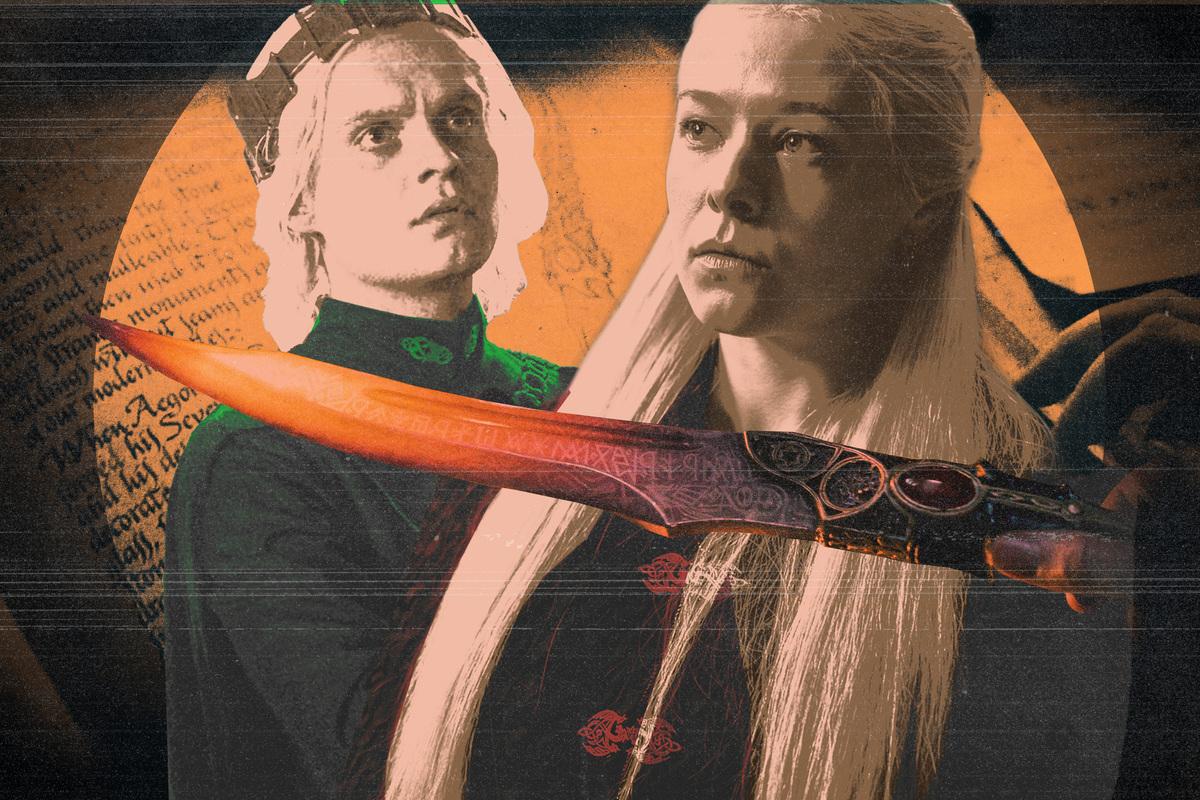How ‘House of the Dragon’ Rewrote the History of Westeros
A reader reviews some significant deviations from George R.R. Martin’s source text, grades the book’s historians, and makes predictions for Season 2

Beware! Book spoilers ahead! Unless you’ve already consumed the portions of Fire & Blood that House of the Dragon is adapting (or you just don’t care about spoilers), turn back now.
Halfway through Season 1 of House of the Dragon, we took stock of the first five episodes with the source text in mind: How closely was the show following Fire & Blood? How well was it foreshadowing certain characters’ evolutions? And, most of all, who was winning the historian duel between the two most-cited sources for Fire & Blood’s narrative, Eustace and Mushroom?
Now that Season 1 is over, it’s time for another book reader check-in. One final reminder before we begin: Descriptions of future events from the books are coming after this paragraph. Stop reading now if you’re afraid of spoilers!
Aegon the Conqueror’s prophecy
By far the show’s most important addition to A Song of Ice and Fire canon so far is the introduction of Aegon the Conqueror’s prophecy about a darkness coming from the North. Given that even book readers didn’t know about this prophecy, there is surely plenty more to come from this new wrinkle, which George R.R. Martin notably endorsed.
Yet despite Martin’s involvement, I was still underwhelmed by the role the prophecy plays in Season 1—and by how it affects the broader story. On some level, the prophecy adds intrigue and a greater understanding to longtime mysteries, like why Aegon V ordered the fires at Summerhall and why Rhaegar was so obsessed with finding the prince that was promised.
But the prophecy also opens up meaningful plot holes elsewhere in the canon. I already discussed a big one in a mailbag: What happened during the winters that surely came and went during the time jumps between episodes of the show? Does King Viserys do anything to strengthen defenses at the Wall because he believes the apocalypse is coming? As book readers know, winter arrives during the Dance, so maybe we’ll see Rhaenyra treat the situation with the urgency such a forecast requires—but that Viserys, who believes so strongly in dreams, isn’t shown to is an indictment of the show’s only-when-it’s-convenient incorporation of the prophecy so far.
In most stories, this oversight wouldn’t be a huge deal—but Martin’s fictional world is typically so airtight and logically consistent, all its gears so intricately tuned, that this sort of hole is unusual. Moreover, the prophecy’s ultimate resolution in Season 8 of Game of Thrones might directly contradict its text, given that the White Walkers were defeated even though a Targaryen didn’t sit the Iron Throne at the time. And more broadly, that rushed resolution means House of the Dragon is centering one of the most (eventually) unsatisfying parts of the story.
The prophecy also introduced issues within Dragon. The misunderstanding at the end of Episode 8, when Alicent confuses Aegons as she overhears Viserys’s final words, is more reminiscent of a silly sitcom plot than something from a gritty, grounded show like Dragon or Thrones. In my view, the fallout falls flat in Episode 9, as the greens use his foolish miscommunication to justify their crowning of Aegon, when they already had enough reasons—like Westeros’ institutional patriarchy and sexism, a central theme of the show—to do so.
Perhaps the prophecy will play better in Season 2 and beyond—or even in other spinoffs beyond Dragon, or in the last two ASOIAF books—but through one season of television, it’s generated far more questions than answers.
Targaryens and Velaryons: The next generation
The most important new characters in the back half of Season 1 are Rhaenyra and Alicent’s (and, to a lesser extent, Daemon and Laena’s) kids. Viewers had barely met any of the children before the decade-long midseason time jump, either because they were infants or because they weren’t yet born. Some of these introductions were more effective than others.
On the plus side, Alicent’s children with Viserys each have their own identities which will inform their future behaviors as the civil war unfolds. (Well, except for Daeron the Daring, who was curiously absent even though the show’s creators say the character will be relevant eventually.)
Helaena is weird, but in an entertaining, harmless way; she’s easily the most innocent character in the family, which will only heighten the tragedy coming for her early in Season 2. Aegon II’s character is also made eminently clear (perhaps excessively so), and his change in demeanor in Episode 9—when he shifts from reluctant ruler to new king embracing the cheers of the crowd during his coronation—properly prepares his character for Season 2. And the parallels between Aemond and Daemon are particularly powerful, giving the greens a rogue prince of their own and planting the seeds for the two warriors’ eventual clash over the Gods Eye.
Rhaenyra’s children are less defined, however; Lucerys’s death was more meaningful for the spectacle of Vhagar’s titanic power than because Luke himself was a beloved character. Nor is it easy to sum up the characters of Jacaerys and Joffrey in a single line, as is possible with Alicent’s kids. Jace in particular needs stronger definition in Season 2.
The kids Rhaenyra has with Daemon, meanwhile, inspire timeline questions, which the show has otherwise discarded now that it’s (probably?) finished with big time jumps. Aegon the Younger appears to be a toddler still; is he old enough to fly on Stormcloud in an emergency, as he does in Fire & Blood to escape the Gullet?
Meleys’s canon-breaking crash
One of the joys of Dragon for a book reader is tracking the “objective” history of the Dance of the Dragons, as compared to the biased accounts collected in Fire & Blood. For the most part, House of the Dragon’s deviations still fit within the historiographical nature of that source text. Laenor’s secret survival is a perfect example: Every source in the book agrees he’s dead, but that just means the ruse that Daemon and Rhaenyra concocted succeeded in fooling everyone. The fact that they all think Rhea Royce died after an accident is another example; if only Daemon knew the truth of his first wife’s death, then Mushroom, Eustace, and friends wouldn’t have known the real story to jot down for prosperity.
To be fair, there are other, more minor instances in which the screen strays from the page. For instance, Otto Hightower delivers the greens’ peace terms in Episode 10, rather than Grand Maester Orwyle, a less central character than the hand. These smaller-scale deviations are excusable given the structural differences between a book and a TV show.
But Rhaenys’s departure from Aegon’s coronation is a much more dramatic break from the story’s in-universe consistency, because Fire & Blood’s description of the event suggests a peaceful procession. This moment, more than any other, removes the veneer of connectivity between the two sources, because it’s impossible that all of the historians would have missed a dragon crashing through the floor of the coronation and killing countless attendees.
(The coronation’s description in Fire & Blood does have one very funny moment, now that we know how the event unfolds on the show. The text explains that the greens chose the location in part because “the pit’s thick walls, strong roof, and towering bronze doors made it defensible, should traitors attempt to disrupt the ceremony.” Notice what part of the structure is missing from that list: the floor.)
As I opined in the immediate aftermath of Episode 9, it seems like the showrunners wanted a dramatic dragon scene, logic be darned. With greater time to reflect, I now feel that that desire compromised both the internal consistency of the story and its characters, and the meta relationship between page and screen.
Mushroom vs. Eustace
At each book reader check-in, we’re tracking the diverging claims of Fire & Blood’s sources to determine which is the most accurate historian. The scoring is simple: A historian gets a point for a correct claim that nobody else makes and loses a point for an inaccurate claim that nobody else makes; if the historians are all in agreement on a certain topic, their points don’t change whether they’re all right or all wrong.
Midway through Season 1, Septon Eustace was in the lead with a net score of zero points, while scandalous jester Mushroom had negative two. Here’s a play-by-play of the points they—plus a new source, Maester Munkun—gain and lose in the back half of Season 1:
- Mushroom says that Rhaenyra, Laenor, and Qarl all shared the same bed on occasion. Minus one point.
- Mushroom says that Daemon and Laena flew to the ruins of Old Valyria “in defiance of the curse that hung over that smoking wasteland, to search out the secrets of the dragonlords of the old Freehold.” Daemon is interested in dragonlore, but there’s no indication he and his wife travel to Old Valyria. Minus one point.
- Mushroom says that Alicent tells Laenor, “Do keep trying. Soon or late, you may get one who looks like you.” Granted, that quote comes after Luke’s birth on the page and after Joffrey’s birth on the show, but it’s close enough that we’ll give Mushroom the point.
- Big one here: Mushroom says that Harwin Strong is the father of Rhaenyra’s children, while Eustace “raises the rumors only to dismiss them.” Plus three points to Mushroom, one for each son; minus three points to Eustace.
- Mushroom says that Rhaenyra resented Alicent because the former grew “stout and thick of waist” after childbirth while Alicent “remained slender and graceful.” Minus one point.
- Regarding Laenor’s “death,” Eustace says that Qarl killed him because Laenor took another lover, a younger squire. Meanwhile, Mushroom says that Daemon paid Qarl to kill Laenor (to open a spot for himself at Rhaenyra’s side), then slit Qarl’s throat to tie off loose ends. At least Mushroom got the conspirators right, if not the content of their conspiracy. Minus one point for both historians.
- Regarding the mysterious fire at Harrenhal that killed Lyonel and Harwin Strong, Mushroom says that the Sea Snake ordered it “as an act of vengeance against the man who had cuckolded his son,” while Eustace pointed to Daemon. They were both wrong; minus one point each.
- Mushroom says that Rhaenyra and Daemon’s private marriage ceremony resulted from a shotgun wedding. Yet we can surmise from their baby Aegon’s age after the six-year time jump that she wasn’t yet pregnant at this point. Minus one point.
- Mushroom says that Aegon the Elder (that is, Viserys and Alicent’s Aegon) fathered two bastard children. The show places only one on-screen but hints there are more. Plus one point.
- Mushroom says that Aemond toasted his nephews as “three strong boys” at a key dinner, after Viserys left the table. He also says that Aegon grew offended when Jace asked Helaena for a dance, which seems conceivable given Aegon’s lack of manners at the dinner; at the very least, the dance did occur as Mushroom relates. Plus two points.
- Mushroom says that Alicent “hurried King Viserys on his way with a pinch of poison.” Minus one point.
- Munkun calls the gathering of the Small Council immediately after Viserys’s death “the green council.” Given that Dragon stole this term for the title of Episode 9, this is worth a point for the new historian.
- Munkun says that Grand Maester Orwyle—a source for his text—was the first to speak up in defense of Rhaenyra at the green council, while Mushroom and Eustace say it was Lord Beesbury. Minus one point for Munkun; plus one apiece for Mushroom and Eustace.
- All three lose a point for the manner of Beesbury’s death: Munkun for saying he died after being confined to the dungeons, Eustace for saying Criston Cole cut his throat with a dagger, and Mushroom for saying Criston threw his body out of a window.
- Mushroom says that Alicent commented about Rhaenyra during the green council meeting, “Mayhaps the whore will die in childbirth.” Minus one point.
- Mushroom claims that after Viserys’s death, Aegon was found at a child fighting pit, enjoying the company of a young girl. Eustace claims he was found with a paramour who was “the daughter of a wealthy trader.” Minus one point for Eustace, but we’ll call this one a wash for Mushroom because Aegon does spend time at that pit.
- Eustace says that Aegon didn’t want to be part of his mother’s coup at first. Plus one point.
- Mushroom tells the story of Rhaenyra delivering a stillborn child after she learns of Viserys’s death. Plus one point.
- Munkun correctly relates the peace terms that Aegon II offers to Rhaenyra. Plus one point. However, he and Mushroom both get the content of the ensuing meeting wrong because they talk about a conversation between Rhaenyra and Orwyle, rather than Rhaenyra and Otto. Minus one point each.
- Mushroom says that a storm arrived as Luke completed his fateful trip to Storm’s End. Plus one point.
- Mushroom says that after Luke’s death, Aemond “cut out his eyes and presented them to [one of the Baratheon daughters] on a bed of seaweed.” Considering how little of Luke Vhagar appears to leave intact, minus one point.
Collect all those tallies, and the final Season 1 scores are:
- Negative one for Munkun (albeit with much less time to get anything wrong so far)
- Negative three for Mushroom
- Negative five for Eustace
That’s a rough showing for Eustace, who lost his lead in the back half of Season 1. We’ll keep tracking these scores in Season 2 and beyond.
Season 2 predictions
Speaking of Season 2: Although the next 10 episodes of Dragon won’t arrive until 2024, let’s wrap up this column with a set of seven predictions for what will happen, and how audiences will react, when the Dance of the Dragons returns to screens.
- I predict that Alicent and Rhaenyra will take on more vocal, active roles in the war effort, whereas they sometimes faded into the background on the page.
- I predict that the Blood and Cheese event will generate considerable controversy among viewers.
- I predict that the maybe-mythical Sara Snow actually exists. Even if she and Jace don’t actually say their marriage vows before a weirwood tree, I think she’ll add a layer of heat to the show’s journey to the icy North.
- I predict that one of the most touching sequences of the season will be a montage of Nettles slowly bonding with Sheepstealer over the course of so many food deliveries.
- I predict that Criston Cole will ascend to near-Joffrey (the slappable Thrones one, not the cute Velaryon version) levels of hatred from viewers, if he’s not there already.
- I predict that the battle at Rook’s Rest will feature the most spectacular aerial combat in Thrones/Dragon history. Rhaenys and Meleys will go out with considerable drama.
- Finally, predicting the overall contour of Season 2 is a bit trickier than with Season 1, where it wasn’t difficult to anticipate an ending with Lucerys’s death above Shipbreaker Bay. On a Ringer-Verse podcast episode this week, my colleagues Mallory Rubin and Joanna Robinson forecasted that Season 2 might end with the Battle of the Gullet and Jace’s death. But I predict that Season 2 will end with Rhaenyra taking King’s Landing, and meeting face-to-face with Alicent for the first time all season. This endpoint would offer a triumphant contrast to Rhaenyra’s final moment of Season 1—and represent the political peak of her story line, allowing Season 3 to depict her slow, sorry demise in the capital city.

